Related Research Articles
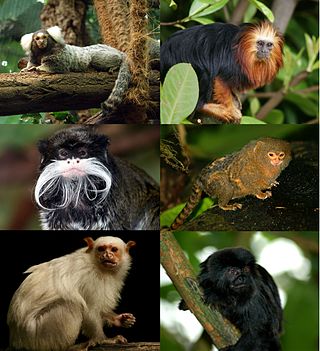
The Callitrichidae are a family of New World monkeys, including marmosets, tamarins, and lion tamarins. At times, this group of animals has been regarded as a subfamily, called the Callitrichinae, of the family Cebidae.

Ruminants are hoofed herbivorous grazing or browsing mammals that are able to acquire nutrients from plant-based food by fermenting it in a specialized stomach prior to digestion, principally through microbial actions. The process, which takes place in the front part of the digestive system and therefore is called foregut fermentation, typically requires the fermented ingesta to be regurgitated and chewed again. The process of rechewing the cud to further break down plant matter and stimulate digestion is called rumination. The word "ruminant" comes from the Latin ruminare, which means "to chew over again".

The marmosets, also known as zaris or sagoin, are twenty-two New World monkey species of the genera Callithrix, Cebuella, Callibella, and Mico. All four genera are part of the biological family Callitrichidae. The term "marmoset" is also used in reference to Goeldi's marmoset, Callimico goeldii, which is closely related.

Pygmy marmosets are two species of small New World monkeys in the genus Cebuella. They are native to rainforests of the western Amazon Basin in South America. These primates are notable for being the smallest monkeys in the world, at just over 100 g (3.5 oz). They are generally found in evergreen and river-edge forests and are gum-feeding specialists, or gummivores.

In zoology, a folivore is a herbivore that specializes in eating leaves. Mature leaves contain a high proportion of hard-to-digest cellulose, less energy than other types of foods, and often toxic compounds. For this reason, folivorous animals tend to have long digestive tracts and slow metabolisms. Many enlist the help of symbiotic bacteria to release the nutrients in their diet. Additionally, as has been observed in folivorous primates, they exhibit a strong preference for immature leaves which tend to be easier to masticate, are higher in energy and protein, and lower in fibre and poisons than more mature fibrous leaves.

The buffy-tufted marmoset, also known as the buffy tufted-ear marmoset or white-eared marmoset, is a New World monkey that lives in the forests on the Atlantic coast of southeast Brazil. Of all the marmosets, it has the southernmost range.
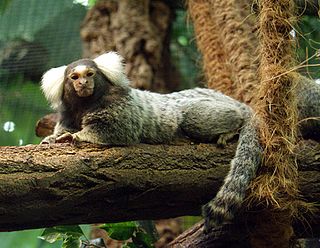
The common marmoset also called white-tufted marmoset or white-tufted-ear marmoset is a New World monkey. It originally lived on the northeastern coast of Brazil, in the states of Piaui, Paraiba, Ceará, Rio Grande do Norte, Pernambuco, Alagoas, and Bahia. Through release of captive individuals, it has expanded its range since the 1920s to Southeast Brazil, where it became an invasive species, raising concerns about genetic pollution of similar species, such as the buffy-tufted marmoset, and predation upon bird nestlings and eggs.

The black-tufted marmoset, also known as Mico-estrela in Portuguese, is a species of New World monkey that lives primarily in the Neo-tropical gallery forests of the Brazilian Central Plateau. It ranges from Bahia to Paraná, and as far inland as Goiás, between 14 and 25 degrees south of the equator, and can commonly be seen in the City of Rio de Janeiro where it was introduced. This marmoset typically resides in rainforests, living an arboreal life high in the trees, but below the canopy. They are only rarely spotted near the ground.

The buffy-headed marmoset is a rare species of marmoset endemic to the rainforests of south-eastern Brazil. It occurs in southern Espírito Santo and possibly northern Rio de Janeiro and its distribution extends into Minas Gerais.

The Philippine flying lemur or Philippine colugo, known locally as kagwang, is one of two species of colugo or "flying lemurs". It is monotypic of its genus. Although it is called "flying lemur", the Philippine flying lemur is neither a lemur nor does it fly. Instead, it glides as it leaps among trees.

The Masoala fork-marked lemur, also known as the eastern fork-marked lemur or Masoala fork-crowned lemur, is a species of lemur found in the coastal forests of northeastern Madagascar. It is a small nocturnal animal with large eyes, greyish fur and a long tail.

The southern needle-clawed bushbaby is a species of strepsirrhine primate in the family Galagidae. Found in Cameroon, Central African Republic, Republic of the Congo, and possibly Democratic Republic of the Congo, its natural habitat is tropical moist forests. While the species is not threatened or endangered, some local populations may be threatened by habitat destruction.

Fork-marked lemurs or fork-crowned lemurs are strepsirrhine primates; the four species comprise the genus Phaner. Like all lemurs, they are native to Madagascar, where they are found only in the west, north, and east sides of the island. They are named for the two black stripes which run up from the eyes, converge on the top of the head, and run down the back as a single black stripe. They were originally placed in the genus Lemur in 1839, later moved between the genera Cheirogaleus and Microcebus, and given their own genus in 1870 by John Edward Gray. Only one species was recognized, until three subspecies described in 1991 were promoted to species status in 2001. New species may yet be identified, particularly in northeast Madagascar.
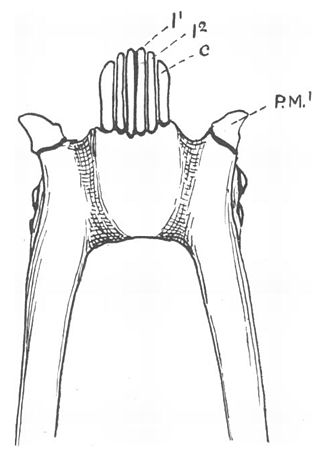
A toothcomb is a dental structure found in some mammals, comprising a group of front teeth arranged in a manner that facilitates grooming, similar to a hair comb. The toothcomb occurs in lemuriform primates, treeshrews, colugos, hyraxes, and some African antelopes. The structures evolved independently in different types of mammals through convergent evolution and varies both in dental composition and structure. In most mammals the comb is formed by a group of teeth with fine spaces between them. The toothcombs in most mammals include incisors only, while in lemuriform primates they include incisors and canine teeth that tilt forward at the front of the lower jaw, followed by a canine-shaped first premolar. The toothcombs of colugos and hyraxes take a different form with the individual incisors being serrated, providing multiple tines per tooth.
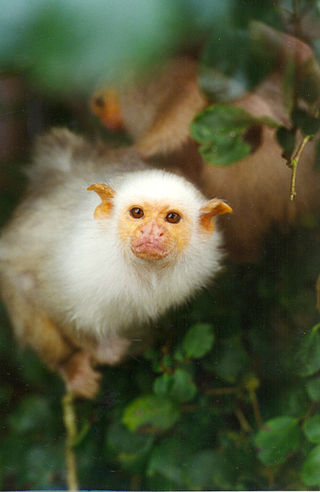
Mico is a genus of New World monkeys of the family Callitrichidae, the family containing marmosets and tamarins. The genus was formerly considered a subgenus of the genus Callithrix.

Callithrix is a genus of New World monkeys of the family Callitrichidae, the family containing marmosets and tamarins. The genus contains the Atlantic Forest marmosets. The name Callithrix is derived from the Greek words kallos, meaning beautiful, and thrix, meaning hair.
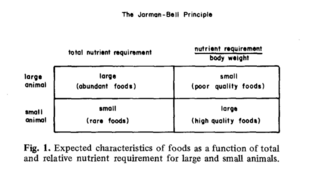
The Jarman–Bell principle is a concept in ecology that the food quality of a herbivore's intake decreases as the size of the herbivore increases, but the amount of such food increases to counteract the low quality foods. It operates by observing the allometric properties of herbivores. The principle was coined by P.J Jarman (1968.) and R.H.V Bell (1971).

The western pygmy marmoset is a marmoset species, a very small New World monkey found in the northwestern Amazon rainforest in Brazil, Colombia, Ecuador, and Peru. It was formerly regarded as conspecific with the similar eastern pygmy marmoset, which has whitish underparts. Although the western pygmy marmoset occurs further west than the eastern pygmy marmoset, the primary separators of their ranges are the Amazon River and Marañón River, with the western occurring to the north of them and the eastern to the south.
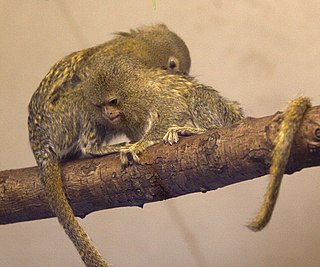
The eastern pygmy marmoset is a marmoset species, a very small New World monkey, found in the southwestern Amazon Rainforest in Bolivia, Brazil, Ecuador, and Peru. It was formerly regarded as conspecific with the similar western pygmy marmoset, but the eastern pygmy marmoset has whitish colored underparts. Although the eastern pygmy marmoset occurs further east than the western pygmy marmoset, the primary separators of their ranges are the Amazon River and Maranon River, with the western occurring to the north of them and the eastern to the south. The species has recently been confirmed by DNA testing to exist in Ecuador, hundreds of kilometers north of the Maranon River.
References
- 1 2 3 4 5 6 Merrit, J. (2010). The biology of small mammals. (pp. 89–93). Baltimore, Maryland: Johns Hopkins University Press. Retrieved from Google Books.
- ↑ Plavcan, J. M., & Kay, R. (1962). Reconstructing behavior in the primate fossil record. (pp. 165–170). New York, NY: Kluwer Academic/ Plenum Publishers. Retrieved from Google Books.
- ↑ Nash, Leanne T. (1986). "Dietary, behavioral, and morphological aspects of gummivory in primates". American Journal of Physical Anthropology. 29 (S7): 113–137. doi:10.1002/ajpa.1330290505.
- 1 2 3 Power, ML; Myers, EW (December 2009). "Digestion in the common marmoset (Callithrix jacchus), a gummivore-frugivore". American Journal of Primatology. 71 (12): 957–63. doi: 10.1002/ajp.20737 . PMID 19725117. S2CID 205329282.
- ↑ Anderson, D. M. W.; Bell, P. C. (1975-10-01). "Structural analysis of the gum polysaccharide from anacardium occidentale". Analytica Chimica Acta. 79: 185–197. doi:10.1016/S0003-2670(00)89430-1. ISSN 0003-2670.
- ↑ Huber, HF; Lewis, KP (2011). "An assessment of gum-based environmental enrichment for captive gummivorous primates". Zoo Biology. 30 (1): 71–8. doi:10.1002/zoo.20321. PMID 21319210.